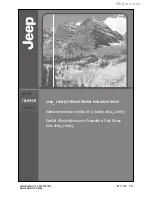
©
2017 Sensata Technologies
Page 28
Installation
2.6.4.1 Example to Determine the Size of the PV System Conductors and OCPD’s
Find the PV System conductors and OCPD size:
Scenario: The PV system will be installed in an area where the average high temperature is
26°C. The array has three PV strings (six current-carrying conductors), these source conductors
are bundled together and connect to a fused string combiner. The lowest temperature rating of
any terminal is 75°C. The modules have a short circuit current rating (I
SC
) of 6.99 amps and a
maximum reverse current rating of 16 amps.
A) Find the PV Source circuit conductor and OCPD size:
Step 1 -
Calculate the maximum current for the PV source circuits (I
MAX
).
• M
ax current for PV source (PV
SOURCE
-I
MAX
) = Module I
SC
x 1.25 = 6.99 x 1.25 =
8.74
Step 2 -
Determine the conductor size for the continuous currents (I
CONT
).
a)
Calculate the continuous current for the PV source circuits (I
CONT
).
• C
ontinuous current for PV source (PV
SOURCE
-I
CONT
) = PV
SOURCE
-I
MAX
x 1.25 = 8.74 x
1.25 =
10.92
b)
Find the conductor sized for continuous current (Lowest terminal temperature = 75°C).
• Co
nductor sized to continuous currents =
14 AWG @ 75°C (20 amps)
.
Per Table 310.15(B)(16), 14 AWG is the smallest cable listed @ 75°C and rated 20 amps.
Step 3 -
Determine the conductor size for the maximum currents for the PV source circuits
derated after adjustment factors (I
DERATE
).
a)
Calculate the ampacity of the conductors after derating by “conditions of use” factors:
• Ma
x PV source circuit current with conditions of use (PV
SOURCE
-I
DERATE
) = (PV
SOURCE
-I
MAX
÷ Fill Factor ÷ Temp Factor) = 8.74 ÷ 0.80 ÷ 1 (no Temp Factor derate) =
10.93
1.
Conduit Fill Factor [from Table 310.15(B)(3)(a)] - adjustment for six current-carrying conduc-
tors bundled together is 80% (0.80).
2. Temperature Correction Factors (ambient tempe rooftop adder) - there is no derate
based on temperature. The ambient temperature is 26°C, so there is no derate as it is below 30°C.
There is no rooftop adder because the PV source conductors are not installed close to rooftop.
b)
Find the conductor size after derating factors have been applied:
(Lowest terminal temperature = 75°C, and using USE-2 (90°C) cable)
• Co
nductor sized after derating factors =
14 AWG @ 75°C (20 amps).
P
er Table 310.15(B)(16), 14 AWG @ 90°C has an ampacity of 25 amps; however, since
the terminal temperature is 75°C, the cable ampacity under the 75°C column is used.
So, 14 AWG is the smallest cable listed under the @ 75°C column and is rated 20 amps.
Step 4 -
Determine the minimum required conductor size: 14 AWG @ 75°C (20 amps).
The largest conductor between the continuous current conductor (Step 2b) and the derating factors
conductor (Step 3b) is the minimum conductor size used. In this instance, they are the same.
Step 5 -
Size the Overcurrent Protection Device (OCPD) to protect the selected conductor.
The OCPD should be a commonly available size (see NEC Article 240.6), and sized to be:
a) equal to or greater than the Continuous Current (see Step 2a) = 10.92; and
b) less than or equal to the Minimum Required Conductor
ampacity (see Step 4) = 20 amps
A 15-amp OCPD is recommended
, this is the next highest standard value above the
design current of 10.92 amps. This size will meet all requirements for each PV source
conductor ampacity and is less than the maximum reverse current of 16 amps.
Note:
If the OCPD is rated for 100% operation, then it can be sized to the lower I
MAX
current (Step 1).
Note:
The OCPD for each PV source conductor cannot exceed the “Series fuse” listed on the module
label.
Note:
Consult manufacturer for OCPD rating if exposed to temperatures greater than 40
°
C.
















































